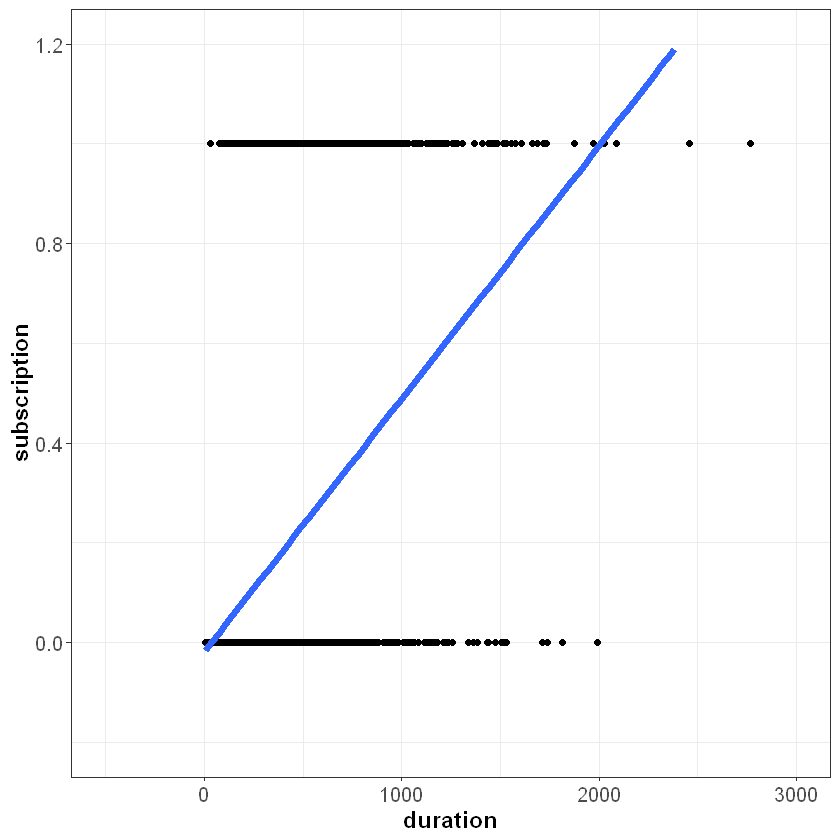7.1. Why Not Linear Regression?¶
At this point, a natural question might be why one cannot use linear regression to model categorical outcomes. To understand why, let’s look at an example. We have a data set related to a telephone marketing campaign of a Portuguese banking institution. Suppose we would like to model the likelihood that a phone call recipient will make a term deposit at the bank. The data is saved in a data frame called deposit, and the first few observations are shown below:
head(deposit)
| age | marital | education | default | housing | loan | contact | duration | campaign | previous | poutcome | subscription |
|---|---|---|---|---|---|---|---|---|---|---|---|
| 30 | married | primary | no | no | no | cellular | 79 | 1 | 0 | unknown | 0 |
| 33 | married | secondary | no | yes | yes | cellular | 220 | 1 | 4 | failure | 0 |
| 35 | single | tertiary | no | yes | no | cellular | 185 | 1 | 1 | failure | 0 |
| 30 | married | tertiary | no | yes | yes | unknown | 199 | 4 | 0 | unknown | 0 |
| 59 | married | secondary | no | yes | no | unknown | 226 | 1 | 0 | unknown | 0 |
| 35 | single | tertiary | no | no | no | cellular | 141 | 2 | 3 | failure | 0 |
These variables are defined as follows:
age: The age of the person contacted.marital: The marital status of the person contacted.education: The education level of the person contacted.default: Whether the person contacted has credit in default.housing: Whether the person contacted has a housing loan.loan: Whether the person contacted has a personal loan.contact: How the person was contacted (cellularortelephone).duration: The duration of the contact, in seconds.campaign: The number of contacts performed during this campaign for this client.previous: The number of contacts performed before this campaign for this client.poutcome: The outcome of the previous marketing campaign (failure,nonexistent, orsuccess).subscription: Whether the person contacted made a term deposit (1if the person made a deposit and0if not).
Let’s try using linear regression to model subscription as a function of duration:
depositLinear <- lm(subscription ~ duration, data = deposit)
summary(depositLinear)
Call:
lm(formula = subscription ~ duration, data = deposit)
Residuals:
Min 1Q Median 3Q Max
-1.47629 -0.11329 -0.05758 -0.01963 1.00009
Coefficients:
Estimate Std. Error t value Pr(>|t|)
(Intercept) -1.488e-02 6.203e-03 -2.399 0.0165 *
duration 4.930e-04 1.675e-05 29.436 <2e-16 ***
---
Signif. codes: 0 '***' 0.001 '**' 0.01 '*' 0.05 '.' 0.1 ' ' 1
Residual standard error: 0.2926 on 4519 degrees of freedom
Multiple R-squared: 0.1609, Adjusted R-squared: 0.1607
F-statistic: 866.5 on 1 and 4519 DF, p-value: < 2.2e-16
Based on this output, our estimated regression equation is:
If we plot this line on top of our data, we can start to see the problem:

Our independent variable subscription can only take on two possible values, 0 and 1. However, the line we fit is not bounded between zero and one. If duration equals 2,500 seconds, for example, the model would predict a value greater than one:
A negative value of duration does not make sense in this context, but in principle the same problem applies in the opposite direction - for small values of \(X\), the linear model might predict outcomes less than zero. To overcome this issue, logistic regression models the dependent variable \(Y\) according to the logistic function, which is bounded between zero and one.
